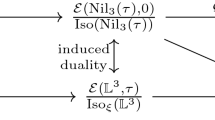Abstract
We discuss bases of the space of holomorphic quadratic differentials that are dual to the differentials of Fenchel–Nielsen coordinates and hence appear naturally when considering functions on the set of hyperbolic metrics which are invariant under pull-back by diffeomorphisms, such as eigenvalues of the Laplacian. The precise estimates derived in the current paper form the basis for the proof of the sharp eigenvalue estimates on degenerating surfaces obtained by the authors in another paper.


Similar content being viewed by others
References
Buser, P.: Geometry and Spectra of Compact Riemann Surfaces. Progress in Mathematics, vol. 106. Birkhäuser, Boston (1992)
Große, N., Rupflin, M.: Sharp eigenvalue estimates on degenerating surfaces (2017). arXiv:1701.08491
Hummel, C.: Gromov’s Compactness Theorem for Pseudo-holomorphic Curves. Progress in Mathematics, vol. 151. Birkhäuser, Basel (1997)
Masur, H.: Extension of the Weil–Petersson metric to the boundary of Teichmüller space. Duke Math. J. 43, 623–635 (1976)
Mazzeo, R., Swoboda, J.: Asymptotics of the Weil-Petersson metric. IMRN 6, 1749–1786 (2017)
Randol, B.: Cylinders in Riemann surfaces. Comment. Math. Helv. 54, 1–5 (1979)
Rupflin, M., Topping, P.M.: A uniform Poincaré estimate for quadratic differentials on closed surfaces. Calc. Var. Partial Differential Equations 53, 587–604 (2015)
Rupflin, M., Topping, P.M.: Teichmüller harmonic map flow into nonpositively curved targets. J. Differential Geometry 108(1), 135–184 (2018)
Rupflin, M., Topping, P.M., Zhu, M.: Asymptotics of the Teichmüller harmonic map flow. Adv. Math. 244, 874–893 (2013)
Rupflin, M., Topping, P.M.: Horizontal curves of hyperbolic metrics. Calc. Var. 57, 106 (2018)
Wolpert, S.: The Fenchel–Nielsen deformation. Ann. of Math. 3, 501–528 (1982)
Wolpert, S.: Spectral limits for hyperbolic surfaces. II. Invent. Math. 108(1), 91–129 (1992)
Wolpert, S.: Geometry of the Weil–Petersson completion of Teichmüller space. Surv. Differ. Geom. VIII, 357–393 (2003)
Wolpert, S.: Behavior of geodesic-length functions on Teichmüller space. J. Differential Geom. 79, 277–334 (2008)
Wolpert, S.: Geodesic-length functions and the Weil–Petersson curvature tensor. J. Differential Geom. 91, 321–359 (2012)
Yamada, S.: On the Weil–Petersson geometry of Teichmüller spaces. Math. Res. Lett. 11(3), 327–344 (2004)
Yamada, S.: Local and Global Aspects of Weil–Petersson Geometry. Handbook of Teichmüller Theory IV. EMS, Zurich (2014). arXiv:1206.2083v2
Author information
Authors and Affiliations
Corresponding author
Appendix A. Appendix
Appendix A. Appendix
We will need the following “Collar lemma” throughout the paper.
Lemma A.1
(Keen–Randol [6]) Let (M, g) be a closed oriented hyperbolic surface and let \(\sigma \) be a simple closed geodesic of length \(\ell \). Then, there is a neighbourhood \(\mathcal {C}(\sigma )\) around \(\sigma \), a so-called collar, which is isometric to \(\big ((-\,X(\ell ),X(\ell ))\times S^1, \rho ^2(s)(\mathrm{d}s^2+\mathrm{d}\theta ^2)\big )\) where
On collars, we will always use the complex variable \(z=s+\mathrm {i}\theta \).
We will use in particular the following properties of hyperbolic collars, and refer to [1] as well as the appendices of [8,9,10] and the references therein for more information:
The width of a collar, i.e. the distance \(w_{\ell }\mathrel {\mathrm {:=}}\int _{-X(\ell )}^{X(\ell )} \rho (s) \mathrm{d}s\) between the two boundary curves, is related to the length \(\ell \) of the central geodesic by
The injectivity radius of points on the boundary curves of a collar is at least \(\mathrm{arsinh}(1)\) and as the injectivity radii and conformal factors \(\rho \) are of comparable size at points with bounded (euclidean) distance, we hence have that
with \(c_\Lambda >0\) depending only on \(\Lambda \), compare e.g. [8, (A.7)–(A.9)].
In our analysis of holomorphic quadratic differentials, we use repeatedly that on a collar \(\mathcal {C}(\sigma )\) around a geodesic of length \(\ell \in (0,2\mathrm{arsinh}(1))\) we have
where norms on \(\mathcal {C}(\sigma )\) are always computed with respect to \(g=\rho ^2(\mathrm{d}s^2+\mathrm{d}\theta ^2)\).
We also remark that for every \({\bar{L}}\), there exists a constant \(c_1=c_1({\bar{L}})>0\) so that if \(\ell <{\bar{L}}\) then
while an upper bound of the form
holds true for a universal constant C.
As the principal part is orthogonal to the collar decay part, we may combine the above estimates with
to obtain a trivial upper bound for the coefficient of the principal part on collars of
so in particular
for collars around geodesics of bounded length \(L_g(\sigma )\le {\bar{L}}\).
Rights and permissions
About this article
Cite this article
Große, N., Rupflin, M. Holomorphic quadratic differentials dual to Fenchel–Nielsen coordinates. Ann Glob Anal Geom 55, 479–507 (2019). https://doi.org/10.1007/s10455-018-9636-y
Received:
Accepted:
Published:
Issue Date:
DOI: https://doi.org/10.1007/s10455-018-9636-y



